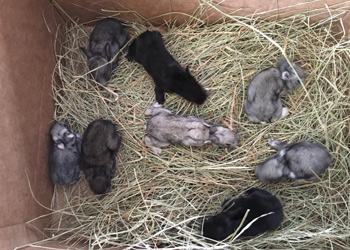1. Why doesn’t my doe have babies after she has been bred?
a. This could be due to any number of reasons. Perhaps she’s not getting enough sunlight, the buck may not be fertile, or it simply might be that it was just not a successful breeding. However, don’t be concerned unless she has had 3 failed breedings. At that time, try breeding her to a different buck, or possibly move her out of your breeding program.
2. Is there a way to increase the chances that my doe will become pregnant after she has been bred?
a. Yes. The most common ways are to increase the amount of exposure to light, add apple cider vinegar drinking water, feed the doe fresh parsley as a treat, & after she has been bred, as soon as the buck ‘falls off, flip her over onto her back & slightly elevate her rear end. Also, when breeding, allow them to mate at least 3 times in one session. Some breeders will do this twice within a 24-hour period.

Young flemish giant babies

Newborn flemish giants
3.What do I do if my doe absolutely refuses to breed?
a. As strange as it sounds, it works! – take her for a ride in the car. The vibrations of being in a vehicle will stimulate her. Immediately upon taking her out of the car, put her with the buck you are wanting her bred to (remember, do not leave them unattended while breeding, especially if one of them often becomes aggressive while breeding).
b. You may also want to try to assist. To do this, sit the doe on the table & place one hand over her shoulders while placing your other hand under her to tilt her rear end upwards; make sure her tail is out of the way, & hold her in that position until the buck takes care of business.
4. Can my buck & doe live together in the same hutch/cage?
a. Yes – however be advised that unless one or both have been spayed/neutered, they will breed – & once the doe delivers the babies, she can become very aggressive towards the buck, or the buck may attempt to kill the babies, & he will also re-breed her very quickly, which is not healthy for the doe.
5. How often can my doe have babies?
a. A doe should not be bred more than 2-3x per year. This allows her time to have her babies, wean them, & then have a resting period before having another litter.
6. Why is it bad practice to breed any color of Flemish together?
a. Because breeding colors that are not compatible to each other results in offspring that does not meet breed standards, one breeding can mess up the lineage of those giants for many, many generations, & furthermore certain colors have different characteristics to their fur, so wrong-breedings can/will cause problems with their fur.
7. If I only breed my Flemish to sell the babies as pets, why does it matter what color they are or what colors are bred together?
a. Because someone buying one from you may decide to start their own pedigree, believing they have high quality show-worthy rabbits, & after 3 years of work, finances, & time invested the next several litters are loaded with fur & coloration problems & every rabbit they had sold from those genetics – as top quality show animals – will then also be highly likely to discover the same problems, & so on. In other words… just do not do it!
